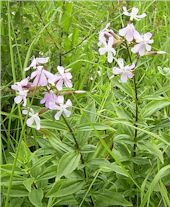|

Soapwort |
The Soapwort (Saponaria officinalis) grows commonly in England near villages, on roadsides, and by the margins of woods, in moist situations. It belongs to the Caryophyllaceoe, or Clove and Pink tribe of plants; and a double flowered variety of it is met with in gardens. This is Miss Mitford's "Spicer" in "Our Village". It is sometimes named "Bouncing Bet," and "Fuller's herb."
The root has a sweetish bitter taste, but no odor. It contains resin and mucilage, in addition to saponin, which is its leading principle, and by virtue of which decoctions of the root produce a soapy froth. Saponin is likewise found in the nuts of the Horse-chestnut tree, and in the Scarlet Pimpernel.
A similar soapy quality is also observed in the leaves, so much so that they have |
been used by mendicant monks as a substitute for soap in washing their clothes. This "saponin" has considerable medicinal efficacy, being especially useful for the cure of inveterate syphilis without giving mercury. Several writers of note aver that such cases have been cured by a decoction of the plant; though perhaps the conclusion has been arrived at through the resemblance between the roots of Soapwort and those of Sarsaparilla.
Gerard says: "Ludovicus Septalius, when treating of decoctions in use against the French poxes, mentions the singular effect of the Soapwort against that filthy disease"; but, he adds, "it is somewhat of an ungrateful taste, and therefore must be reserved for the poorer sort of patients." He employed it soepe et soepius.
The "Pharmacopoeia Chirurgica" of 1794, teaches: "A decoction of this plant has been found useful for scrofulous, impetiginous, and syphilitic affections. Boil down half a pound of the bruised fresh herb in a gallon of distilled water to two quarts, and give from one to three pints in the twenty-four hours."
Formerly the herb was called Bruisewort, and was thought of service for contusions. It will remove stains, or grease almost as well as soap, but contains no starch.
Saponin, when smelt, excites long-continued sneezing; if injected or administered, it reduces the frequency and force of the heart's pulsations, paralyzing the cardiac nerves, and acting speedily on the vaso-motor centres, so as to arrest the movements of the heart, on which principle, when given in a diluted form, and in doses short of all toxic effects, it has proved of signal use in low typhoid inflammation of the lungs, where restorative stimulation of the heart is to be
aimed at.
Also, likewise for passive suppression of the female monthly flow, it will act beneficially as a stimulant of the womb to incite its periodical function.
In a patient who took a poisonous quantity of Saponin at Saint Petersburg all the muscular contractile sensitiveness was completely abolished; whilst, nevertheless, all the bodily functions were normally performed. Per contra, this effect should be a curative guide in the use of Soapwort as a Simple.
Saponin is found again in the root and unripe seeds of the Corn Cockle, and in all parts of the Nottingham Catch-fly except the seeds; also in the wild Lychnis, and some others of the Pink tribe.
Herb Simples
The Primitive Simplers presented here show the way of life in other generations, it is not suggested or recommended trying them yourself. |
|
Garden
Herbs
Home
History of Herbs
Herb Gardening
Herbs for Beginners
Drying & Preserving Herbs
Indoor Herb Gardening
Herb Garden
Hints & Tips
Herbal
Cooking
Herb Chart
Using Herbs
Culinary Herbs
Herb
Oil and Vinegar
Herb Teas
Herb Candy
Herb Jelly
Herb Simples
Preface
Introduction
Alphabetical Listing

Trade
Recipes Online
Share your Recipes with others!!
|


